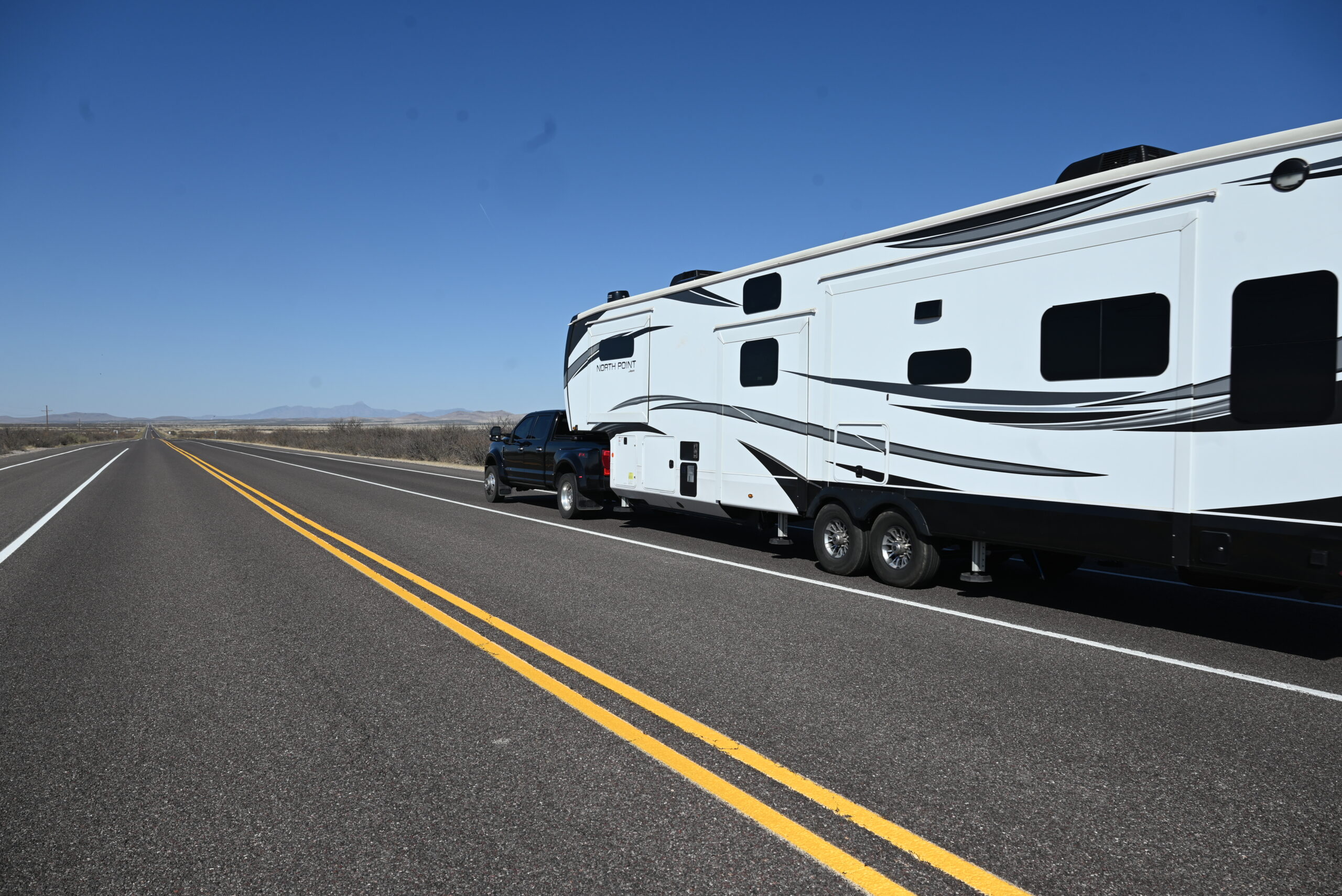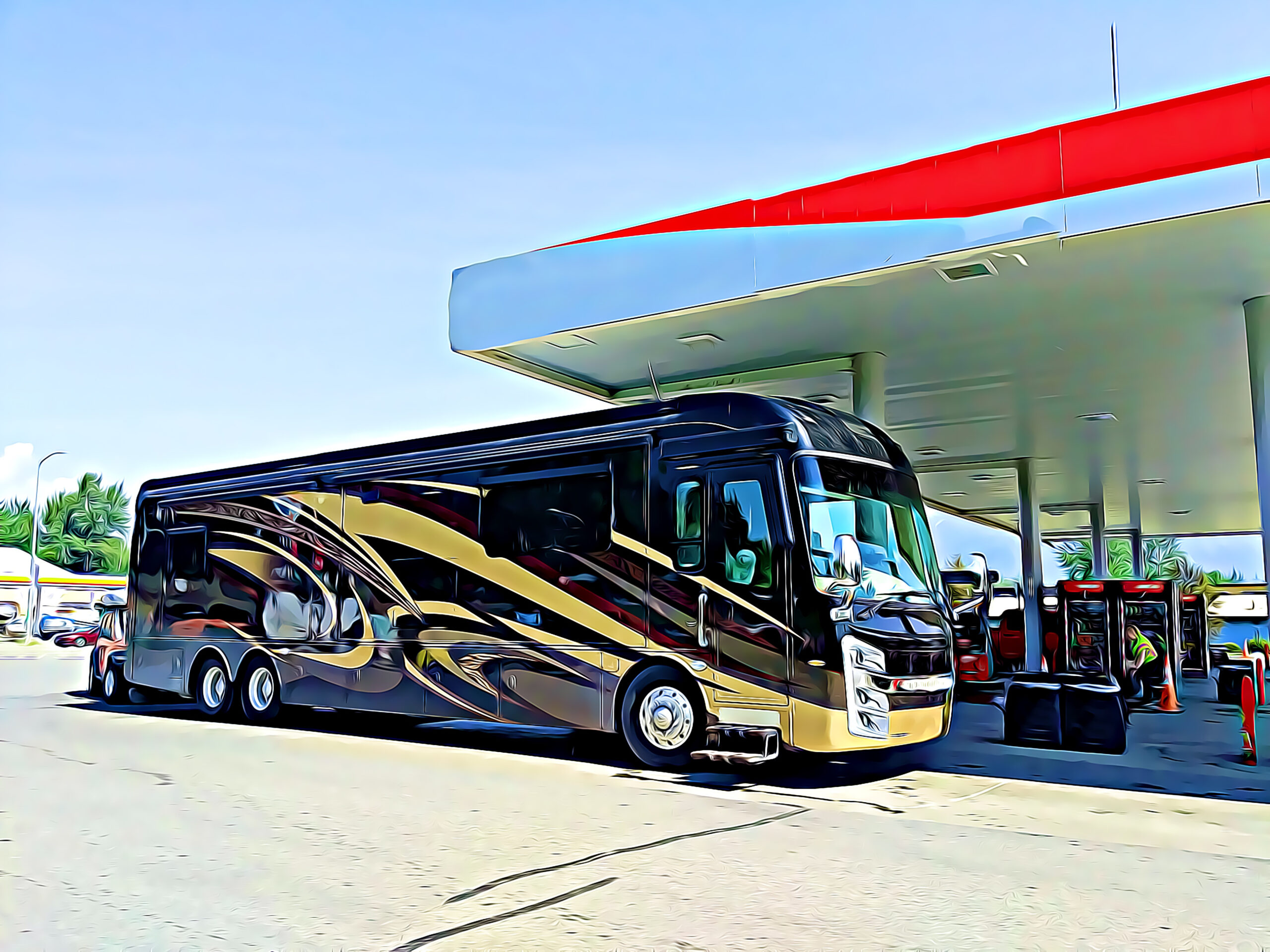
10 RV Driving Tips That Every Class A RV Owner Should Know
Driving a Class A motorhome is not like driving a passenger vehicle. These large RVs:
- Are much bigger
- Take longer to stop
- Are top heavy
- Have a longer wheel base
- Are slower to respond to abrupt steering corrections
- Can be easily pushed around by strong winds
- And they need to be driven closer to the left lane marker than a car, SUV, pickup, or van.
Keeping all this in mind, let me start by saying that you need to keep both hands on the wheel, and be prepared for the unexpected.
Just like an airline pilot mentally rehearses what if scenarios, you need to mentally rehearse what if scenarios in your Class A RV, so if the unexpected does happen, you already have a plan. The following safe RV driving tips will make for a more enjoyable trip.
RV Driving Tips For Class A Motorhome Owners
1. Know the height, weight, width, & length of your Class A RV
One of the first RV driving tips that you need to know is your RV’s specific dimensions, including the height, weight, width, and length of your rig. This may sound like a no-brainer, but from the minute you drive away in your newly purchased RV, you could be facing road hazards that you had never even considered when you were driving a passenger size vehicle. The dealer or seller will be the best source for this information, so you need to ask about the RV’s dimensions if the seller doesn’t volunteer that information.
These dimensions should be etched into your mind, and you need to always consider them when driving your RV. At some point in your travels, you will encounter low overhead obstacles, and some will be in places where you least expect them. For example, canopies over gas pumps may be too low for larger Class A motorhomes. Wires, limbs, tunnels, bridges, and overpasses may be lower than the height of your RV. Bridges, areas of road construction, and narrow country roads may have width or weight restrictions. Winding narrow roads with tight switchbacks might be impassible in a Class A motorhome with or without a tow vehicle.
All wires and tree limbs are supposed to be a minimum of 14 feet above roadways, and no Class A RV is taller than 14 feet. So, there shouldn’t be a conflict, but we have seen many wires that sag well below 14 feet on hot days, and hundreds of low tree limbs hanging over the road. Additionally, the height of your RV might be higher than the factory dimensions if you or someone else has installed (or you haul) extra equipment on the roof. If you hit any of these obstacles, they will do a great deal of damage to your RV, even at very low speeds.
Today, there are mobile apps to help you avoid many of these road hazards like low overpasses, or bridges with weight limits. RV LIFE offers a whole suite of mobile apps that make RVing easier, more fun, and safer.
- RV LIFE Trip Wizard helps you plan your trips and find campgrounds based on your vehicle’s specific dimensions.
- RV LIFE Campgrounds helps you find great places to camp.
- The RV LIFE App With RV-Safe GPS is the crown jewel of these apps. You can put the dimensions of your RV into the app and it will help you find roads to any destination that are safe for your RV’s unique dimensions.
RV-safe GPS was not available when we first started on our RV adventure, so we never knew what we might encounter in new places. But now we never go anywhere in our RV without first checking the road ahead in the RV LIFE App.
These tools are extremely helpful, but you still need to be mindful of your RV’s dimensions. The RV-safe GPS will not include information about low limbs or gas station canopies. These apps are tools to help you, but ultimately, you’re the driver and you need to see the hazards and drive accordingly.
2. Know where your controls are and what they do
Again, this may seem obvious, but when you’re driving a Class A motorhome, even if you have a lot of experience driving a big rig, you need your focus to be on the road ahead and the traffic around you. You shouldn’t be searching around for how to turn on your back-up camera or adjust the air flow that keeps your windshield clear.
Before you ever start driving your RV, sit in the driver’s seat and familiarize yourself with all the controls like the windshield wipers, lights and high beam switch, heated mirror switch, mirror adjustment panel, tow haul switch, cruise control buttons, etc. You will eventually need all of these controls, and knowing where they are and how they work is critical to keeping your mind on your driving. If you haven’t driven your RV for some time, be sure to repeat this procedure. Your RV is different from your passenger vehicle, and you need to know where everything is in the RV.
3. Learn to turn
As mentioned in our previous RV driving tips, a Class A motorhome is much more difficult to drive and turn than a regular passenger vehicle. In most cases, you’re sitting on top of the front wheel and the back wheels are many feet behind you. You need to wait a little longer to start your turn or the back wheels will be off the road, out of the lane, dragging over the top of the picnic table, or worse, colliding with a gas pump or some other vehicle.
It takes practice to get a feel for when to turn, and the best place to practice that is in an empty parking lot. If you don’t have access to cones, then use small cardboard boxes to simulate lane widths, curbs, fire pits, or other obstacles that you might encounter in an RV park or on a roadway.
If possible, have your traveling partner watch from outside the coach to see how you navigate through the obstacles. Most large parking lots will have traffic lanes already marked, and you can use those as a guide to see if you can turn a 90-degree corner and keep all your tires in the lane.
Try to imagine what that would be like in a gas station with pumps on both sides, or think about what you may encounter driving your new RV through the narrow residential streets to your home.
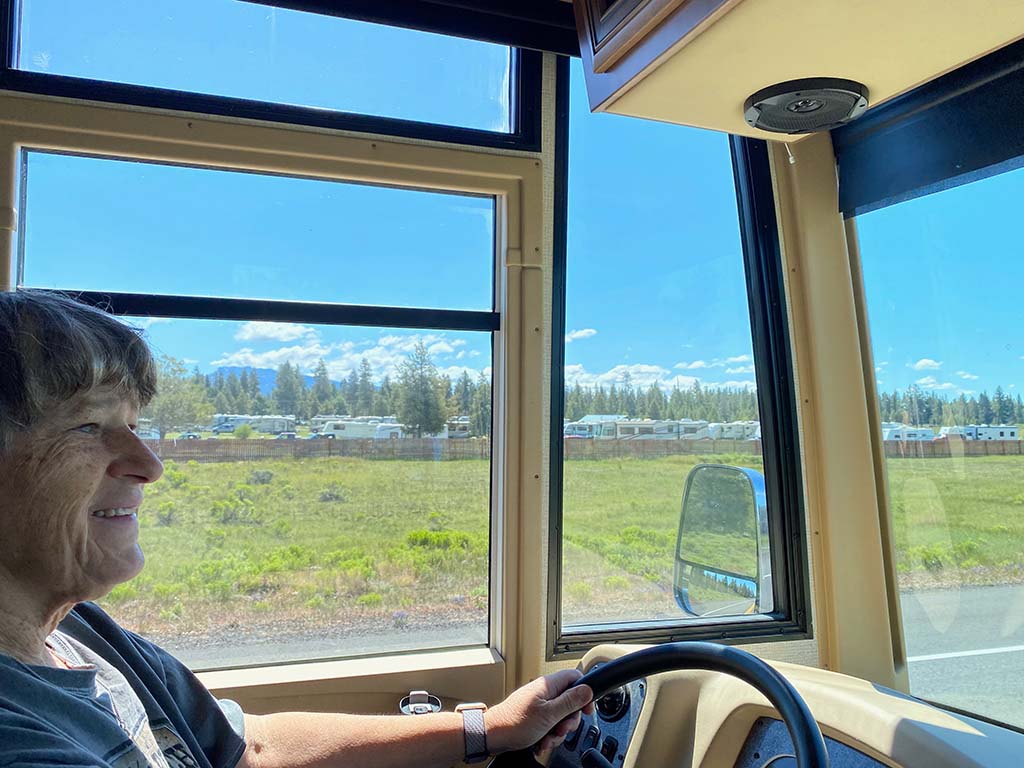
4. Remember your tail whip
In the previous RV driving tips, we focused on keeping all your tires in the lane when turning a 90-degree turn, but there is another unique hazard when driving a Class A motorhome that you never need to worry about when driving a car or truck. It’s called tail whip. Because there is so much of the body of a Class A motorhome behind the back wheels, when turning a sharp 90-degree turn, the back end of the RV will extend out of the lane on the opposite side as the direction of your turn. For example, if you are turning to the right, the tail whip will be at the back on the left side of the RV.
Again, imagine you are at the gas pumps. There are pumps on your left, cars on your right, and the exit out of the parking lot is a sharp turn to the right. If you are too close to the pump and you start that hard right turn before the back of your RV has cleared the pumps, there’s a good chance the tail whip will cause the left back side of your RV to hit the pump, damaging your RV and the gas pump.
Tail whip can also be a danger when you’re in a narrow turn pocket on a city street and there are stopped cars in the lane beside the turn pocket. If you begin your turn too soon before the back end of your RV has cleared the cars, there is a possibility the back of your RV will swing out of your lane, into their lane, and cause a collision.
All city driving with sharp 90-degree turns presents the conditions for a tail whip accident. In addition to thinking about keeping your tires in the lane, you need to be mindful of how much room you have between your RV, all the cars in any lane next to your RV, parked cars, and road signs.
Parking lots are equally difficult to maneuver when other cars, posts, gas pumps, or signs limit how much room you have for your turns. The sharper the turn, the more the back end will dramatically whip in the opposite direction. Move forward slowly until the back of the RV is beyond the obstacle before starting your turn, or try to make your turn less angular. In some cases, you may simply have to wait for the cars beside you to move on.
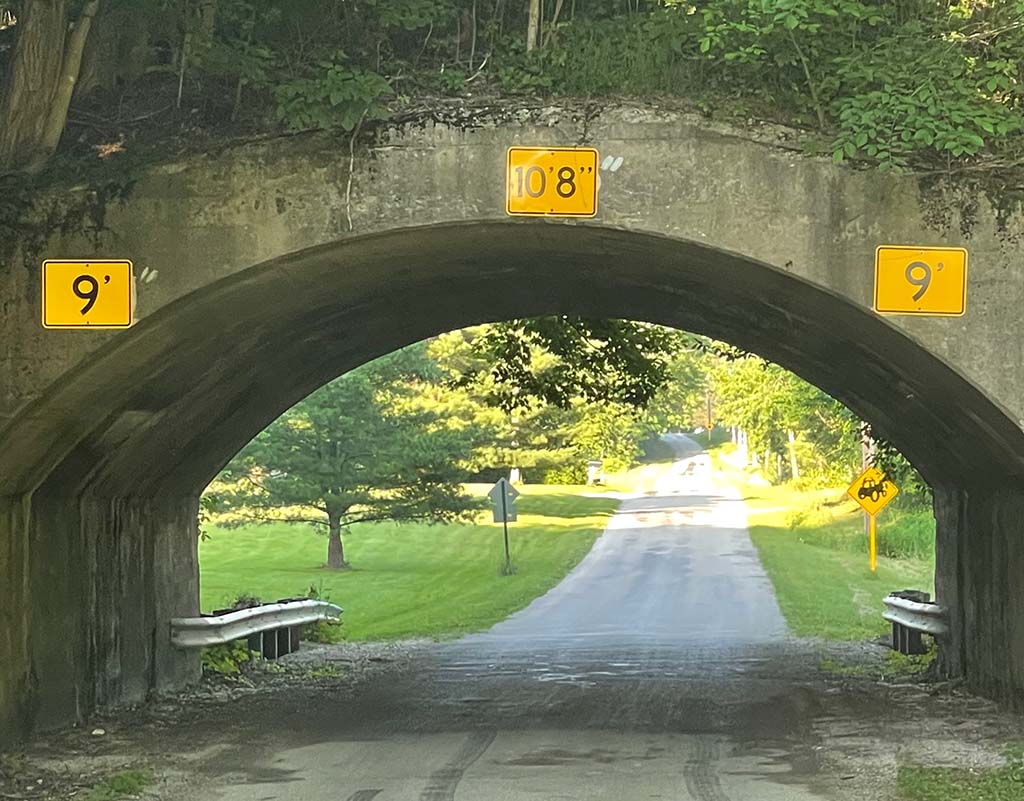
5. Slow down! It’s not a race
Driving at a safe speed is one of the most important RV driving tips on our list. The speedometer on your Class A motorhome may go all the way to 100 MPH, but excessive speed in a Class A motorhome is hazardous. Many places in the US have speed limits of 80 MPH.
Personally, I would never drive my Class A motorhome that fast. These are large heavy vehicles that are hard to stop, and they’re a little top heavy.
It’s just not prudent to drive as fast as the passenger cars around you. Many truckers get paid by the mile, so they are incentivized to get on down the road quickly, but you’re not paid to cover the distance as fast as possible, so slow down, enjoy the drive, and let the trucks and passenger cars go around you. I’m not advocating for poking along a freeway at 45 MPH, but 70 and 80 MPH in a large motorhome doesn’t give you any time to react if a deer or armadillo steps out into the road, or another motorist has a blowout or another emergency in front of you.
6. Watch your lane position
Next up on our list of RV driving tips is to watch your lane position. Driving a Class A RV creates a different perspective than driving a passenger vehicle. There’s a tendency to drive too far to the right because you’re judging the position of the RV based on where your car would be in that same lane. But a Class A RV is wider than a passenger car, so you need to drive the RV closer to the left lane marker to be sure the right side of the RV is fully within the lane. You see this “hugging the right lane marker” phenomena in most new RV drivers.
The safest place to drive is in the center of the lane. If you have a traveling companion that is sitting on the right side of the RV, then ask them to help you. They can easily see when you’re too close to the right lane marker, because from their seat it looks like you’re about to drive off the road.
It can be nerve-racking to be a passenger in an RV when the driver won’t keep the motorhome in the center of the lane. It also confuses other drivers and makes them nervous. You need to find the center and work to stay there. Check your back-up camera occasionally, it will show you where you are in the lane or check your side mirrors.
If you’re driving too close to the right side, you could hit some road debris, or your tires might get caught on uneven pavement joints and pull you even further to the right. It takes time to get this right, but you need to fine-tune staying in the center of the lane on freeways because on smaller backroads you won’t have any extra lane width.
Additionally, you’re sharing the road with a lot of trucks. Their visibility is limited, so when a trucker passes you, if you can signal them when it’s safe to reenter your lane, they will appreciate it, and it makes driving on a freeway with these big rigs safer. I typically flash my lights once to let the trucker know they are past me and it’s safe to move over. I also check the truck’s position in their lane when they are starting to pass me to make sure they’re not drifting right back into my lane before they are fully past my RV.
I have avoided a couple of accidents with trucks because I’m watching for them to drift back. On more than one occasion, I had to quickly move into the emergency parking lane on the right side of the freeway to avoid being sideswiped by a truck. These guys do their best, but they make mistakes too, so be aware of what the trucks are doing around you and give them as much room as possible.
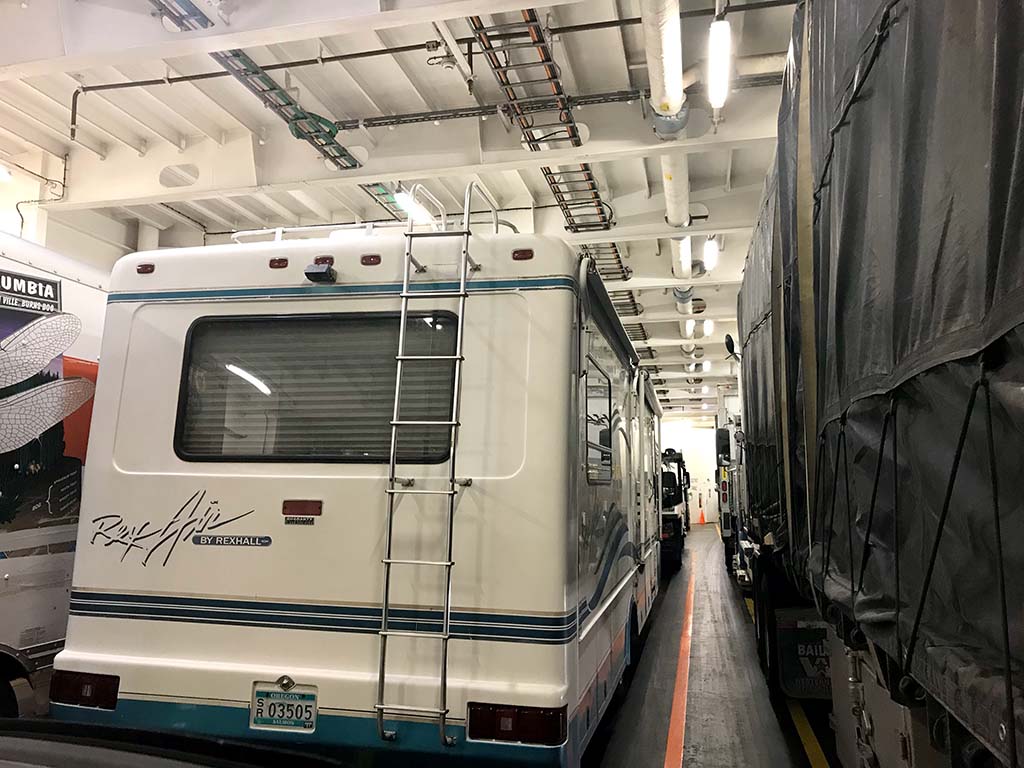
7. Focus far down the road
One of our next RV driving tips is to focus as far down the road as possible. If there is an obstruction, debris in the roadway, another motorist in trouble, a deer or other wildlife along the side of the road, or some other hazard, by seeing it early you have time to react, slow down, move over, signal to other drivers that there’s a problem ahead, or take evasive actions to stay out of trouble. If you’re closely following a truck that limits your vision down the road, it’s much more dangerous because you’re relying on them to alert you that a hazard is ahead. They may not, or if they do, it may not give you enough time to react.
Also, in this regard, I strongly advise you to not drive in the dark. It limits how far and how much you can see, and it greatly increases your chances of being involved in an accident. Additionally, driving in the dark can be more stressful, especially if it’s raining, there’s a lot of tire spray, and the lane markers are hard to see. You might think it’s safer to drive at night with less cars on the road, but truckers drive all night and the reduction in passenger cars does not outweigh the extra hazards of low visibility and wildlife on the road.
8. Don’t drive when you’re tired
This is one of the most important RV driving tips, as it could save your life one day. Don’t drive when you’re not at your best. It’s dangerous in any vehicle, but in an RV, it’s even more so. If you’re groggy, stressed, fatigued, or under the influence of any substance, you’re just not alert. You might miss some subtle danger signs or make a bad decision, and in a Class A motorhome, you don’t have a lot of room for error. If you have been driving for a few hours and notice that you’re getting groggy or fatigued, then stop and take a break.
Take an extra 30 minutes to just check your emails, eat some lunch, and review the road ahead in the RV LIFE App. You’ll feel better when you get back to driving and you’ll be more alert. After checking all your interior and exterior systems, it’s comforting to get back in the driver’s seat with a little fresh air in your lungs and the knowledge that all your systems look good. And after a short break, you’re refreshed and ready to concentrate on the next section of road.
9. Use the GOAL System
Another one of the most important RV driving tips is to inspect your vehicle every time you hit the road. Before you start on each day’s journey, use the GOAL system to check your coach and tow vehicle. This stands for Get Out And Look.
When you first start on your daily journey, you might have your traveling partner (if you have one) stand outside the RV to check all the lights, then as you pull forward a few feet, they can make sure the coupling device on the tow vehicle is working properly and the tires on your tow vehicle are moving freely as they should.
After you’ve been driving for a few hours, you should stop at a rest stop and implement the GOAL strategy. You can have something to eat, use the restroom, drink a glass of water, then walk around your RV and check all the basements, tires, awnings, tow vehicle, windshield, lights, and engine. Truckers do this at virtually every stop. You never know until you check that everything is ok.
The GOAL system might also be necessary when you’re getting gas. Walk your exit. Look at the overhead obstacles, check the distance you have between the RV and the pumps, and determine if tail whip is going to be a problem. If in doubt, ask your co-pilot to confirm that you have cleared the pumps before you start your hard turn toward the exit.
We were following a Class A RV that should have started its journey with a GOAL inspection. They had a bike rack attached to their ladder with two bicycles fastened onto the bike rack. They took a freeway exit that had a significant bump at the beginning of the off ramp, and the entire bike rack and bikes bounced off the back of the RV and landed in the middle of the exit road. The RV driver was unaware that their bikes had become a road hazard and they continued on their journey. I’m sure they were bewildered when they finally did stop and noticed that their bikes were gone. A simple GOAL system check at the beginning of the day would probably have eliminated this loss and the dangerous road hazard.

10. Stay on a road
Now this may seem like one of the more obvious RV driving tips, but it has served us well. We have a philosophy that no matter what we need to just stay on a road. If we miss an exit, or take one too soon, or get off the main road, or misunderstand some directions, the philosophy is to stay calm and stay on the road. Don’t panic and don’t try to do an emergency correction. As long as you are on a road, you can find a way to fix your error.
I have stopped and walked my way out of a couple of problems. I have had to drive through narrow residential streets to get back to a main road. I’ve had to sit through a couple of sequences of lights to get enough clearance in an adjacent lane to safely make a turn. I’ve had to take the tow car off to get the RV turned around, but whatever I’ve encountered, I just stayed on the road, pulled over as soon as it is safe, and try to figure out the best correction. Just don’t panic, and don’t do something stupid. If you’re on a road, you can always find a way to fix whatever situation you are in.
Plan ahead
To lower your stress and to make sure you don’t encounter any low clearance obstacles or other road hazards, be sure to review these RV driving tips carefully, use all the tools available, and plan ahead.
We know a couple who had just traded in their small travel trailer for a Class A motorhome, and when they tried to drive it to Niagara Falls, they ignored a sign that said “No Commercial Vehicles” because they were not in a commercial vehicle. They didn’t realize the sign pertained to a low clearance overpass in the road ahead.
When they got to this low overpass, they were stuck. The road was a divided highway with multiple lanes going in each direction with a grass median in between. They couldn’t turn around and go back, but they couldn’t get their rig under the overpass. They pulled to the side of the road. The police eventually came and gave them a ticket, then he used his police car to clear a way for them to back a mile and a half in the wrong direction of traffic to an exit where they were finally able to get off that roadway. It caused a massive traffic jam. It cost them some money. It was embarrassing and so unnecessary because if they had checked their RV LIFE App, that route would have been shown as a passenger car route only.
If you are just starting your RV journey and you will be driving a Class A motorhome, these RV driving tips will certainly help, but the most important one to remember is to utilize the RV LIFE Pro tools to plan your safe route ahead.
Related articles:


